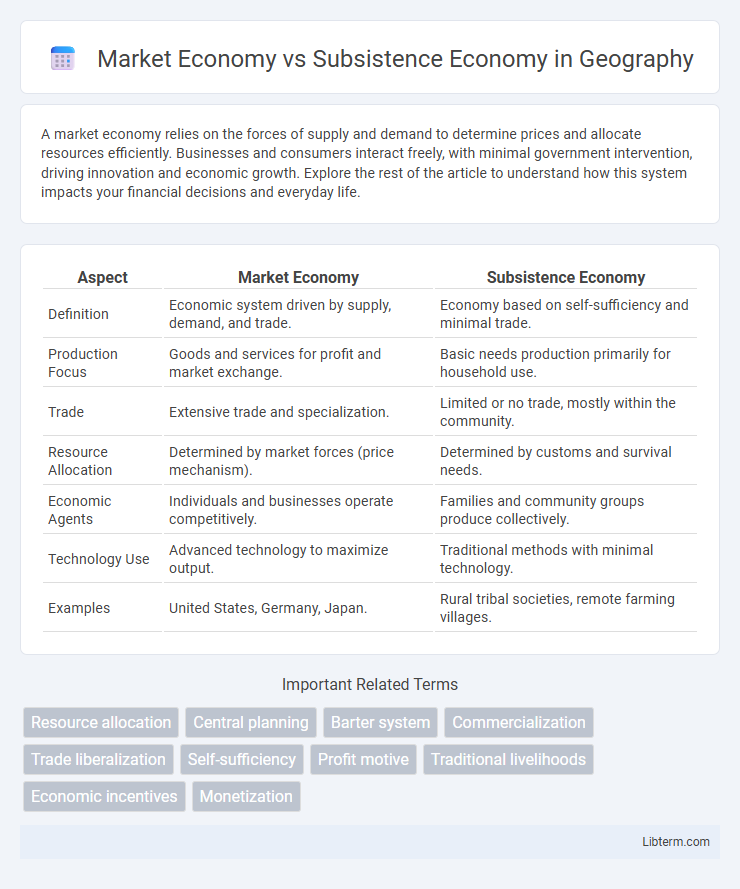A market economy relies on the forces of supply and demand to determine prices and allocate resources efficiently. Businesses and consumers interact freely, with minimal government intervention, driving innovation and economic growth. Explore the rest of the article to understand how this system impacts your financial decisions and everyday life.
Table of Comparison
| Aspect | Market Economy | Subsistence Economy |
|---|---|---|
| Definition | Economic system driven by supply, demand, and trade. | Economy based on self-sufficiency and minimal trade. |
| Production Focus | Goods and services for profit and market exchange. | Basic needs production primarily for household use. |
| Trade | Extensive trade and specialization. | Limited or no trade, mostly within the community. |
| Resource Allocation | Determined by market forces (price mechanism). | Determined by customs and survival needs. |
| Economic Agents | Individuals and businesses operate competitively. | Families and community groups produce collectively. |
| Technology Use | Advanced technology to maximize output. | Traditional methods with minimal technology. |
| Examples | United States, Germany, Japan. | Rural tribal societies, remote farming villages. |
Introduction to Market and Subsistence Economies
Market economies operate on the principles of supply and demand, where goods and services are exchanged through a system of voluntary trade and price mechanisms. Subsistence economies rely primarily on self-sufficiency, producing only enough resources to meet the immediate needs of individuals or communities without surplus for trade. Understanding these economic systems highlights the contrast between resource allocation by market forces versus direct consumption for survival.
Defining the Market Economy
A market economy is an economic system where supply and demand determine the production, distribution, and prices of goods and services, driven by consumer preferences and competition. Unlike a subsistence economy, which focuses on self-sufficiency and producing only what is needed for survival, a market economy encourages specialization and trade to maximize efficiency and wealth creation. Key features include private ownership, voluntary exchange, and minimal government intervention, fostering innovation and resource allocation based on market signals.
Key Features of a Subsistence Economy
A subsistence economy primarily relies on self-sufficient agricultural practices where families produce just enough food and goods to meet their basic needs, without engaging in significant trade or market activities. Key features include minimal surplus production, limited technological advancement, and strong dependence on natural resources and traditional methods. This economy emphasizes survival and community sustenance over profit maximization and market competition seen in a market economy.
Economic Activities: Market vs Subsistence
Market economies rely on the production and exchange of goods and services driven by supply and demand, with participants engaging in specialized economic activities to generate profit and growth. Subsistence economies focus on self-sufficiency, where families or communities produce primarily for their own consumption, involving activities like farming, hunting, and gathering with minimal surplus for trade. Economic activities in market economies emphasize innovation, efficiency, and market expansion, whereas subsistence economies prioritize sustainability and meeting immediate survival needs.
Resource Allocation and Distribution
Market economies allocate resources through the forces of supply and demand, enabling efficient distribution based on consumer preferences and price signals. In contrast, subsistence economies allocate resources primarily for immediate consumption, with distribution centered around fulfilling basic survival needs within households or communities. Market economies rely on decentralized decision-making to optimize resource use, while subsistence economies emphasize self-sufficiency and collective sharing of goods.
Role of Money and Trade Systems
In a market economy, money serves as a universal medium of exchange, facilitating complex trade systems and enabling efficient allocation of resources through supply and demand mechanisms. Conversely, a subsistence economy relies heavily on barter and direct exchange without standardized currency, limiting trade to immediate community needs and self-sufficiency. The role of money in market economies drives economic growth and specialization, while subsistence economies prioritize survival and minimal external trade.
Impact on Standard of Living
Market economies typically generate higher standards of living through increased productivity, innovation, and access to diverse goods and services. In contrast, subsistence economies often result in lower living standards due to limited resource utilization and minimal surplus production. The ability of market economies to facilitate wealth accumulation and improved infrastructure directly influences health, education, and overall well-being.
Economic Growth and Development Prospects
Market economies promote faster economic growth through efficient resource allocation, innovation incentives, and competitive markets that drive productivity gains. Subsistence economies, reliant on self-sufficiency and minimal surplus production, face constraints in scaling economic activities and attracting investment, limiting development prospects. Transitioning from subsistence to market-based systems often fosters infrastructure expansion, technological adoption, and improved standards of living.
Environmental and Social Implications
Market economies prioritize resource efficiency and innovation, often leading to increased environmental degradation due to higher consumption and industrial activity. Subsistence economies typically maintain sustainable practices by relying on local resources and traditional knowledge, which supports biodiversity and reduces ecological footprints. Socially, market economies can drive economic growth and social mobility but may also exacerbate inequality, whereas subsistence economies foster strong community bonds and cultural preservation with limited social stratification.
Conclusion: Comparing Economic Sustainability
Market economies demonstrate higher economic sustainability through efficient resource allocation, innovation stimulation, and scalable growth potential driven by supply and demand dynamics. Subsistence economies, while limited in scalability, maintain sustainability by relying on localized resource use and self-sufficiency, minimizing external dependencies and ecological footprints. The trade-off between these systems reflects market economies' capacity for expansive development versus subsistence economies' emphasis on environmental balance and community resilience.
Market Economy Infographic

 libterm.com
libterm.com